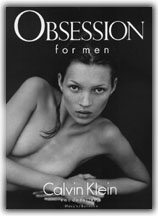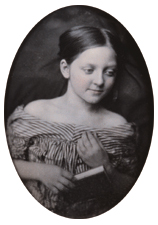Main Menu · Search ·Current Issue ·Contact ·Archives ·Centennial ·Letters to the Editor ·FAQs

 The girl-like Kate Moss in this ad contrasts strongly with the innocent image of childhood from an 1845 daguerreotype (at right).
The girl-like Kate Moss in this ad contrasts strongly with the innocent image of childhood from an 1845 daguerreotype (at right). |
EARLY-ONSET ADULTHOOD
In an 1845 daguerreotype, a young girl embodying childhood innocence, education, and modesty gazes soulfully at the viewer. In a 1995 ad for Calvin Klein's cologne Obsession, a girl-like, naked Kate Moss stares provocatively at the camera without a trace of modesty. "These two images, separated by 150 years, reveal the change in one of the central ideals of childhood," says Kiku Adatto, director of Children's Studies at Harvard. "The innocence of childhood has given way to the portrayal of children as erotic objects."
Childhood as we have known it--the preserve of our best, most natural, and spontaneous selves--is under siege, Adatto told a recent Kennedy School forum on "Sex, Commercialism, and the Disappearance of Childhood." Her children's studies program takes a multifaceted view of childhood and the forces that may be erasing it; funded by the Carnegie Corporation a year and a half ago, the program grew out of Harvard's interfaculty initiative on schooling and children (see "Promoting a National Love of Children," November-December 1996, page 52).
 COLLECTION MATTHEW ISENBURG
COLLECTION MATTHEW ISENBURG |
"The overlay of innocence with eroticism in the Obsession ad creates a dissonance that sells," says Adatto, author of Picture Perfect: The Art and Artifice of Public Image Making (1993). But the eroticization of children to sell products did not begin with Calvin Klein. In the 1960s, the "youthquake" in fashion photography led to anorexic girl-woman models like Twiggy, Adatto notes. At the same time, she adds, photographer Helmut Newton was posing high-fashion models in settings suggesting "illicit sex, violence, and sadomasochism." By 1980, these two trends merged when a 15-year-old Brooke Shields--wearing only designer jeans--declared on billboards and TV screens that "Nothing comes between me and my Calvins."
The discovery of the "child within" during the 1960s played an even larger role. "The impulse to universalize childhood and extend naturalness and spontaneity into adult life seemed at first to be the vigorous reassertion of childhood ideals against the repressive conventions of the fifties," Adatto says. "But once the aspirations and innocence of childhood were appropriated by the adult world, it washed away the boundary between childhood and adulthood. Eros and innocence merged in the public display of nudity as an act of personal and political liberation. So the so-called sexual revolution, coupled with the adult return to the spontaneity of childhood, opened up the way for these erotic images of the child."
In just a few decades, art photography had also moved from Edward Steichen's monumental anthology The Family of Man (1955), which includes a photographic celebration of the idealized freedoms of childhood, to Immediate Family (1992), in which Sally Mann photographed "her own young children nude in erotic poses, or posed as victims of abuse and incest," says Adatto. During the Depression, when Dorothea Lange and Walker Evans photographed children as victims of poverty, they were presented as moral agents for whom we should reform the world. But the current fashion for "heroin chic," which exhibits young models as world-weary drug addicts, creates "'pretend victims' who invite us to be voyeurs" instead of asking us to be agents of change, Adatto argues; today's tabloid culture seeks out victimization for exploitation rather than reform.
The images of childhood that adults create can, of course, shape the ways in which children view themselves. Adatto therefore hopes to foster "democratic readership" among children--helping them to be more than passive consumers of pop-culture identities and cyber-sound-bites. In collaboration with Nieman Foundation curator Bill Kovach, she has gathered journalists, educators, professionals, and scholars from various disciplines to develop curriculums that may transform children and teenagers from "readers as consumers" into "readers as citizens." "Kids aren't reading one of the most important 'books' of all," says Adatto, "and that is the press and other media that open up their world to reflection on public discourse." By teaching children how to be critical masters of the media--rather than its off-camera pawns--Adatto hopes to restore what she calls the "core elements of democracy"--deliberation and community engagement.
She is also leading an interdisciplinary effort at Harvard to document and analyze how childhood has changed since the 1950s. Beavis and Butthead has taken the place of The Howdy Doody Show, families no longer eat together, and children's play looks a lot like adult work, Adatto says: scheduled play dates and activities have replaced spontaneous, unsupervised neighborhood play.
The children's studies program aims to produce a turn-of-the-millennium exhibit and book on the "narratives" of childhood. The most ambitious aspect of Adatto's project is creating an archive of interviews with parents, grandparents, and especially with children. "There's no better way to elevate the voices of children," she says, "than through respecting and listening to their stories--and recording them."
~ Harbour Fraser Hodder